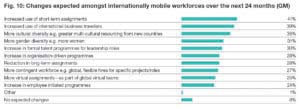Managing Global Mobility programs effectively
Managing Global Mobility programs effectively
Get Off to A Good Start
A solid employee mobility plan encompasses your policies, how the elements of your program are managed, the roles of your internal team along with vendors, and how you work with internal HR and business stakeholders. The most effective employee mobility planning starts with holistic understanding – suspend your assumptions and gather data and perspectives for planning. Below are key points to consider.
- How does your company culture intersect with employees – and how does this impact mobility opportunities? Does your company prefer guidelines or mandate policies?
- What do your businesses need and want (which may not be the same thing)?
- What challenges does each line of business have and how do they relate to company objectives (revenue generating LOBs versus functions like IT or finance)?
- What are your current mobility policies or practices and how receptive are your businesses to change?
- Do you know what your company spends on employee mobility and how many employees you move by policy type?
- What is the budget expectation for each type of mobility event (US domestic homeowner, Intl LTA, Intl STA, etc.)?
- Who are your vendors, what are your internal team roles and who else internally is involved?
Once you have confirmed the information, gathered HR and business leader viewpoints and compiled your findings, you have a good internal framework to start with.
It’s also worthwhile to gather external regional and global surveys and benchmarking, so that you can consider what others are doing – even in other industries or regions. The Santa Fe Global Mobility Survey is a great tool that can help you in your annual review and planning. Figure 10 below is an excerpt from the survey and shows the expected changes to internationally mobile workforces over the next two years.

Source: Santa Fe Relocation GMS 2019: Revision, Mobility through the looking glass.
Create a Great Plan
Now what do you do with all the information that you’ve gathered? We recommend that you don’t jump to conclusions immediately. Identify trends and gaps first, as these may help define elements of your plan.
- Does your current employee mobility program work well and help your businesses relocate talent successfully? If not, what are the challenges that you can identify?
- How do your activity and trends match up with what others are doing in your industry and others? Are there any trends or solutions that might address some of your challenges?
- Does your company have strategic plans or changes that may impact employee mobility over the next few years? Are there any trends or solutions that might help you prepare for these changes?
- Are there actionable steps that others have taken that can benefit your program (gathering global cost and activity data, presenting meaningful data to internal stakeholders, outsourcing services in a different manner than you do today, etc.)?
- How have others enabled a mobility program that can flex to address individual business and employee needs?
Looking objectively at your program, identify changes you can recommend that meet your company’s needs. If your review confirms that elements of your current program are competitive and successfully meeting company objectives, then you can represent these with greater confidence. As you create your updated employee mobility plan, we recommend that you ask several internal stakeholders to review it with you, along with an external review with your relocation management company. Be open to all feedback to ensure that your plan has considered all viewpoints and addresses challenges to change.
Reap the Benefits
Based on the internal and external points you’ve considered, you can now present 1) the facts that support change if needed and 2) your recommendations, both with confidence.
You have addressed your company and business needs for employee mobility and compared your program to global, regional and cross-industry surveys. You have benchmarked your current program and your recommendations considered what other companies are doing and what your company goals are.
Once you successfully receive approval of your recommendations, it is important to execute well.
- Develop a project plan that will allow you to manage the changes.
- Measure the outcomes and help drive accountability for all involved.
- Deliver clear internal communication to stakeholders so that they can participate in the changes, which already took their opinions into consideration!
- Work closely with your relocation management company, consider how they engage with your company, and whether changes impact any of your active employees.
After the changes are implemented, ensure that you have a way to measure all aspects of your program and implement an annual process to review and measure your program’s success. In the rapid pace of economic, political and business changes – along with immigration, tax and legal revisions – adjustments may need to occur with greater frequency.
We recommend that you stay up to speed on trends and information through webinars, white papers, surveys and events. Find more in the Mobility Insights section of our website, https://staging.santaferelo.com.

